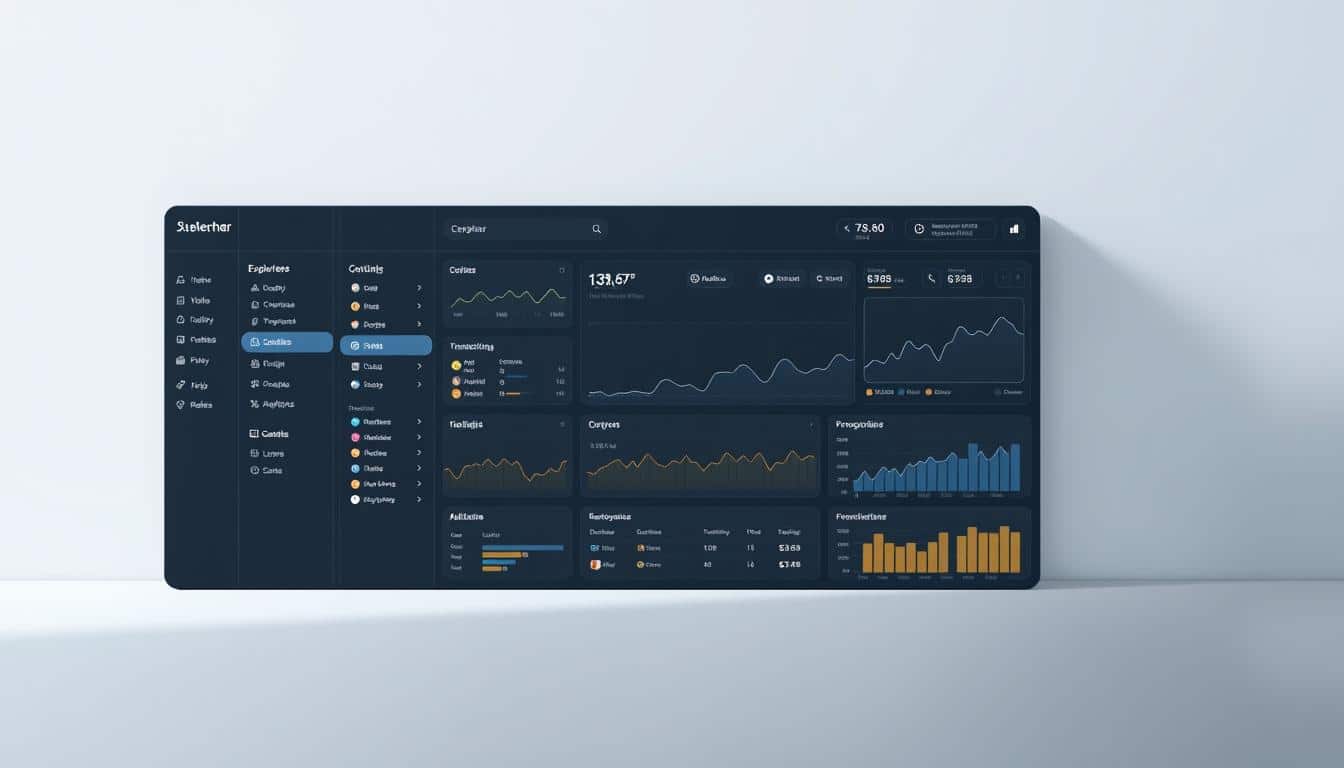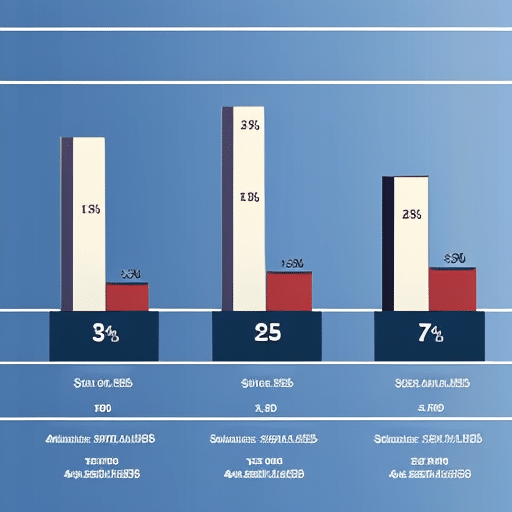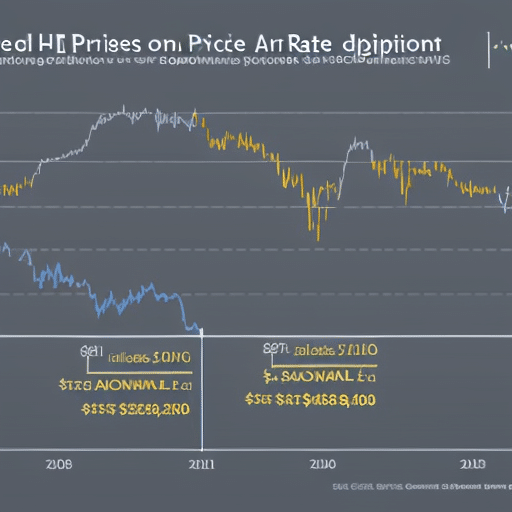How to Use Blockchain Explorer Tools: A Guide
Over 700 million blockchain transactions happen monthly across major networks. Most people don’t know where their crypto goes after sending. I learned this the hard way when starting out.
A block explorer for beginners is like Google Maps for digital money. It shows where transactions travel and when they arrive. I’ve spent hours tracking payments and verifying smart contracts.
These platforms are essential navigation systems for cryptocurrency users. They help confirm payments and investigate blockchain transaction verification. Knowing these interfaces can change your crypto experience.
I once panicked when a transaction seemed to disappear. I was looking at the wrong network. This guide will help you avoid such confusion.
This isn’t about memorizing button clicks. It’s about understanding what you’re seeing and why it matters. Your crypto security and knowledge depend on it.
Key Takeaways
- Blockchain explorers function as search engines for cryptocurrency transactions, letting you track any payment across the network in real-time
- These platforms provide transparent verification without requiring technical expertise or special software installation
- Common beginner mistakes include checking the wrong network or misreading transaction status indicators
- Understanding transaction hashes and wallet addresses forms the foundation for effective explorer navigation
- Explorers serve multiple purposes beyond payment tracking, including smart contract analysis and network health monitoring
- Free explorer platforms offer the same core functionality as premium alternatives for most everyday verification needs
Introduction to Blockchain Explorer Tools
Blockchain explorers are essential tools for understanding cryptocurrency transactions. They transform complex blockchain data into readable information. These tools help verify transactions and navigate the cryptographic world of blockchain technology.
Explorers are crucial for anyone involved in cryptocurrency or blockchain applications. They provide a way to confirm transactions and access important blockchain data. Without them, users would struggle to make sense of the raw blockchain information.
What is a Blockchain Explorer?
A blockchain explorer is a web app that translates raw blockchain data for human understanding. It acts as a search engine for blockchain networks. Users can look up transactions, wallet addresses, blocks, and smart contracts.
Explorers make blockchain data accessible and comprehensible. They’re useful for various tasks related to understanding blockchain data. From confirming payments to checking transaction status, explorers are invaluable tools.
Importance of Blockchain Explorers
Blockchain explorers enable users to verify transactions independently. They provide transparency critical for the entire blockchain ecosystem. Researchers, developers, and even law enforcement rely on these tools.
Explorers offer features like crypto address lookup to troubleshoot transactions. They help analyze network activity and verify the authenticity of digital assets. These tools are essential for maintaining the trustless nature of blockchain technology.
Explorers have various uses beyond basic transaction verification. They can help analyze fee patterns and identify optimal transaction times. The crypto address lookup function helps users avoid sending funds to scam addresses.
Key Features to Look For
Quality blockchain explorers offer specific features that enhance their usability. Search functionality is crucial, allowing users to find information quickly. Real-time updates and clear transaction details are also important features.
Essential blockchain explorer features include:
- Real-time updates: Transaction status should refresh automatically without you having to hit reload constantly
- Clear transaction details: Gas fees, confirmation times, input data – all presented in readable format
- Address history: Complete transaction history for any wallet address you search
- Network statistics: Current gas prices, block times, and network congestion indicators
- API access: For developers who need to integrate blockchain data into their applications
Advanced users should look for token tracking and smart contract verification features. Some explorers offer analytics dashboards to visualize blockchain activity. These tools help in understanding blockchain data patterns over time.
Mobile responsiveness is important for checking transactions on the go. Consider the specific blockchain you’re working with when choosing an explorer. Some support multiple networks, while others specialize in a single chain.
How Blockchain Explorers Work
Blockchain explorers are powerful tools that decode complex blockchain data. They run on servers connected to blockchain nodes, organizing vast amounts of information. These tools act as translators, turning raw data into understandable formats.
Explorers track and show transaction flow through the distributed ledger. They’ve changed how many people interact with crypto. Understanding their workings can greatly improve your crypto experience.
Transaction Tracking Process
Explorers use indexing to track crypto transactions. They maintain huge databases mirroring blockchain contents. When new blocks are mined, explorers quickly add the data to their searchable database.
Searching for a transaction is lightning-fast. The explorer queries its database, finds the data, and displays it in seconds. This speed is impressive, considering the millions of transactions involved.
The continuous synchronization keeps explorers up-to-date. They connect to multiple blockchain nodes, always watching for new blocks. This ensures you see current data, usually within seconds of blockchain confirmation.
| Explorer Component | Primary Function | Update Frequency | Data Source |
|---|---|---|---|
| Node Connection Layer | Maintains real-time connection to blockchain nodes | Continuous | Multiple blockchain nodes |
| Indexing Engine | Parses and organizes blockchain data | Every new block | Raw blockchain data |
| Search Database | Stores indexed transaction and address data | Real-time updates | Indexing engine output |
| API Layer | Serves data to front-end interface | On-demand queries | Search database |
This indexing architecture makes blockchain transaction verification possible. Without it, you’d need to download the entire blockchain yourself. That’s possible, but impractical for most users.
Transparency in Blockchain
Blockchain is transparent, but raw data isn’t easily understood. Viewing every Bitcoin transaction is possible, but making sense of it requires technical skills.
Explorers are crucial for understanding blockchain data. They turn complex data into readable formats. Amounts appear in actual currency units, and timestamps show real dates.
Verifying payments becomes simple with explorers. They show sender’s address, amount, fee paid, and confirmation count. This clarity transforms blockchain from “technically accessible” to “practically useful”.
The real power of blockchain transparency shines through explorers. Anyone can audit transactions or track fund movements without programming expertise. This accessibility opens up blockchain’s potential to a wider audience.
Smart Contracts and Explorers
Smart contracts add complexity to blockchain explorers. These are executable code on the blockchain. Explorers let you view contract source code, execution history, and internal transactions.
Internal transactions occur when smart contracts interact. Good explorers track and display these, crucial for security and trust. This feature is invaluable when assessing DeFi protocols.
Explorers show the full execution trace for smart contract transactions. You can see success or failure, gas consumption, and emitted events. This transparency is vital for practical reasons.
Always check smart contracts on an explorer before sending funds. Look at transaction history and verify the code. This due diligence can protect you from sketchy projects.
Understanding blockchain data through explorers empowers independent verification. You can verify everything independently by examining on-chain activity. This knowledge is key to using crypto safely and avoiding pitfalls.
Popular Blockchain Explorer Tools
Blockchain explorers are essential for navigating the crypto world. Different tools serve various networks and purposes. You’ll likely use multiple explorers depending on your needs and the blockchain you’re working with.
I’ve tested many platforms over the years. Three consistently stand out for their reliability and features. Each has unique strengths and weaknesses. Understanding these helps you choose the right tool for each task.
CoinGecko
CoinGecko is known for price tracking, but its explorer capabilities are underrated. Its multi-chain support is a standout feature. It’s great for quick overviews across different networks without switching tabs.
The interface isn’t technically deep like specialized explorers. However, it offers convenience and accessibility. It’s a time-saver for checking basic transaction status on multiple chains.
Here’s what makes it practical for everyday use:
- Quick price context alongside transaction data
- Support for over 50 blockchain networks
- Clean interface that doesn’t overwhelm beginners
- Integrated market analytics and token metrics
CoinGecko trades detailed features for breadth. It lacks advanced capabilities like contract verification or gas analytics. Consider it a starting point, not a final destination.
Etherscan
For Ethereum or EVM-compatible chains, Etherscan is indispensable. It’s the top Ethereum explorer, offering a wealth of on-chain data. This includes token transfers, gas analytics, and contract verification.
Etherscan’s lesser-known features can prevent costly mistakes. The Name Tag service makes transaction history readable. Transaction simulation shows smart contract interactions before confirmation.
Blockchain explorers are the windows into the distributed ledger, transforming cryptographic data into human-readable insights that drive transparency and trust.
Here’s a practical breakdown of Etherscan’s standout capabilities:
| Feature Category | Functionality | Best Use Case |
|---|---|---|
| Contract Verification | View and verify smart contract source code | Security audits and transparency checks |
| Token Tracking | Monitor ERC-20, ERC-721, and ERC-1155 tokens | Portfolio management and NFT verification |
| Gas Tracker | Real-time gas price monitoring and predictions | Optimizing transaction timing and costs |
| DEX Tracker | Decentralized exchange activity monitoring | Market analysis and trade verification |
Etherscan has a steeper learning curve than simpler explorers. However, once mastered, it becomes an essential tool for blockchain analysis.
Blockchair
Blockchair is my preferred bitcoin blockchain explorer. It also excels at multi-chain searches. The interface is modern and user-friendly, unlike some older explorers.
Blockchair stands out for its privacy-focused approach and powerful search capabilities. You can query blockchains using natural language or complex filters. The interface is intuitive and easy to navigate.
Its bitcoin explorer functionality is particularly strong. It clearly presents data on UTXO movements, transaction fees, and block propagation times. Blockchair supports over 20 blockchains, including Bitcoin, Ethereum, and various privacy coins.
Key advantages include:
- Universal search across multiple chains simultaneously
- Privacy mode that doesn’t log your searches
- Advanced filtering options for precise queries
- API access for developers building applications
- Clear data visualization without unnecessary clutter
Each tool has its strengths and weaknesses. CoinGecko lacks depth, Etherscan can overwhelm newcomers, and Blockchair may lag in supporting newer chains. Together, they cover most blockchain exploration needs.
My workflow involves all three regularly. CoinGecko for quick multi-chain overviews, Etherscan for detailed Ethereum data, and Blockchair for Bitcoin analysis or cross-chain searches. Different tools serve different purposes in blockchain exploration.
How to Access Blockchain Data
Using blockchain tools can be overwhelming at first. But with practice, accessing blockchain data becomes easier. Let’s break down the process into simple steps.
Start with the basics and build your skills gradually. Focus on one aspect at a time. Soon, you’ll navigate these tools with confidence.
Navigating the User Interface
Block explorers have a similar layout. The search bar is your main tool. Bookmark it for quick access to information.
The main menu shows blocks, transactions, and network stats. Use it to browse data systematically. Network stats are usually on the homepage.
The main area displays search results or browsing data. Don’t let the details intimidate you. Most explorers have a dark mode for comfortable viewing.
- Search bar: Central command for all queries
- Navigation menu: Browse blocks, transactions, and tokens
- Network stats: Real-time blockchain health indicators
- Content display: Detailed information tables and charts
- Settings panel: Customization options for your preferences
Searching for Transactions or Addresses
The search function accepts various input types. Knowing which one to use saves time. Transaction hashes are long strings of letters and numbers.
Wallet addresses start with “0x” on Ethereum. Other blockchains have different formats. Block numbers are simple integers, like 15,000,000.
Block hashes identify entire blocks. Most people rarely need to search by block hash.
The search bar is flexible. Paste any valid identifier and hit enter. The explorer figures out what you’re looking for.
| Search Method | What You Need | Information Returned | Best Used For |
|---|---|---|---|
| Transaction Hash | 64-character hex string from your wallet | Complete transaction details, status, fees, timestamps | Tracking your sent or received payments |
| Wallet Address | Public address starting with 0x (Ethereum) or other prefixes | Balance, transaction history, token holdings | Researching wallets, checking balances |
| Block Number | Integer value (e.g., 15000000) | All transactions in that block, miner info, timestamps | Analyzing network activity at specific times |
| Block Hash | 64-character hex string identifying a block | Complete block data, parent/child relationships | Technical blockchain analysis and verification |
Filtering Results for Precision
Filtering is crucial when dealing with large amounts of data. It helps you find relevant information quickly. Date range filtering is a commonly used tool.
Transaction type filters separate incoming from outgoing transactions. Token filters help analyze specific cryptocurrency movements. Value-based filtering shows significant transactions and hides small amounts.
Combining filters increases their effectiveness. It can reduce thousands of transactions to just the ones you need. Always check active filters before assuming data doesn’t exist.
Mastering these techniques will improve your blockchain explorer skills. You’ll move from confused clicking to purposeful navigation. The interface becomes a powerful research tool at your fingertips.
Reading Blockchain Data
Blockchain data is simpler to understand than it looks. You just need to know what matters. Blockchain explorers become useful when you can interpret transaction meanings.
Raw data on these pages tells stories about network activity and transaction success. It even explains why your crypto transfer cost more than expected.
The power of public blockchain explorers comes from understanding what you’re seeing. It’s about more than checking if a transaction went through.
You can see how it happened, what it cost, and what that reveals about network conditions. This insight transforms you from observer to expert.
Understanding Transaction Details
Transaction pages contain more info than most realize. The basics are sender address, receiver address, and amount transferred. But the real insights hide in the additional fields.
The “From” and “To” fields show wallet addresses involved. These long strings identify participants without revealing personal information. Blockchain transaction verification starts here.
Value represents the amount of cryptocurrency transferred. The “Transaction Fee” is separate from this value. You pay this fee even if your transaction fails.
Status might show “Success,” “Failed,” or “Pending.” Failed transactions still cost gas fees. Miners get paid for trying, even if the transaction doesn’t complete.
“The blockchain is an incorruptible digital ledger of economic transactions that can be programmed to record not just financial transactions but virtually everything of value.”
Gas Price shows how much you paid per unit of work. It’s measured in Gwei. Higher gas prices mean faster processing.
Gas Limit versus Gas Used reveals important details. The limit is what you allocated. Gas Used shows what was actually consumed.
The Nonce field tracks transaction order from a specific address. It prevents replay attacks and ensures correct transaction processing.
| Transaction Field | What It Shows | Why It Matters | Common Issue |
|---|---|---|---|
| Transaction Hash | Unique transaction identifier | Used for tracking and verification | Case-sensitive when copying |
| Status | Success, Failed, or Pending | Confirms completion or identifies problems | Failed transactions still cost fees |
| Block Number | Which block contains this transaction | Determines confirmation count | Pending means not yet in a block |
| Gas Price | Fee paid per computation unit | Affects processing speed and cost | Too low causes delays or failure |
| Nonce | Transaction sequence number | Ensures proper transaction ordering | Stuck nonces block subsequent transactions |
Input Data contains additional information for smart contract interactions. For simple transfers, this field is empty. With DeFi protocols, it holds encoded function calls and parameters.
Analyzing Blocks
Blocks bundle individual transactions for permanent recording. Viewing a block gives you a snapshot of network activity at a specific moment.
Block Number shows the sequential position in the chain. Higher numbers mean more recent activity. The current block number reveals chain progress since launch.
Timestamp records block creation time. Target intervals vary by chain. Faster or slower blocks indicate changes in mining difficulty or network participation.
The Miner or Validator field identifies who created the block. On Proof of Work chains, it’s the mining pool. On Proof of Stake networks, it’s the selected validator.
Block Reward shows compensation for block creation. It includes the base reward plus transaction fees. This number can fluctuate dramatically during high network activity.
Difficulty indicates how hard it was to mine a block. This adjusts to maintain consistent block times. Rising difficulty means more miners are competing.
Gas Used versus Gas Limit shows block fullness. Full blocks mean higher fees and slower confirmations. This can cause transactions to get stuck for hours.
Transaction Count reveals how many transactions are in a block. This number varies widely based on network activity. It can range from dozens to thousands.
Recognizing Gas Fees and Confirmation Times
Gas fees often frustrate blockchain users. Understanding why they fluctuate helps with blockchain transaction verification. It also explains how confirmation times relate to network conditions.
Gas powers blockchain operations. Every action uses a specific amount. The price you pay per unit determines transaction priority.
Gas prices follow supply and demand. Low network usage means lower fees. High activity creates an auction for limited block space.
You set the gas price, but the network determines if it’s enough. Set it too low, and your transaction might never process.
Confirmation times correlate with gas prices during congestion. One confirmation means inclusion in a block. Most services wait for multiple confirmations before finalizing.
Bitcoin users typically wait for 6 confirmations. Ethereum often requires 12-35. Each additional confirmation makes transaction reversal exponentially harder.
| Network Condition | Typical Gas Price (Gwei) | Average Confirmation Time | Best For |
|---|---|---|---|
| Low Activity | 15-30 | 30 seconds – 2 minutes | Non-urgent transfers, testing |
| Moderate Activity | 30-80 | 2-5 minutes | Regular transactions, routine swaps |
| High Activity | 80-150 | 5-15 minutes | Time-sensitive trades, DeFi operations |
| Extreme Congestion | 150-500+ | 15 minutes – several hours | Critical transactions only, urgent arbitrage |
Failed transactions still cost gas fees. You pay for the work done, even if the transaction doesn’t complete. The explorer shows “Failed” status but also shows the fee paid.
The “confirmations” counter shows blocks added since yours. This number increases over time. It helps track when deposits will be credited.
Blockchain data analysis can save you money. Check current gas prices before transactions. Wait for quieter periods when possible. Explorer tools make this information transparent.
Advanced Features of Blockchain Explorers
Blockchain explorers offer more than just basic transaction lookups. They’re powerful research platforms used by professionals daily. Advanced features transform simple tools into comprehensive data analysis systems.
The difference between basic and power users isn’t just technical knowledge. It’s about knowing which tools exist and how to use them effectively.
I once tracked a suspected scam wallet using an explorer. I could monitor it continuously, get alerts, and analyze patterns. This changed my approach to blockchain data analysis.
Address and Token Tracking
Address tracking is crucial for effective crypto transaction monitoring. Advanced explorers let you “watch” specific addresses and get notifications about fund movements. This feature helps monitor project treasury wallets and track budget allocation.
Visualization tools show an address’s history as charts, revealing activity over time. Some explorers map relationships between addresses, uncovering networks of connected wallets.
Token tracking allows analysis of specific cryptocurrencies. You can view token holders, track large transfers, and monitor supply changes. I once identified a major token dump two hours before it happened by watching whale wallet movements.
Sophisticated address tracking typically includes:
- Real-time transaction alerts sent to email or mobile devices
- Historical balance charts showing wallet growth over time
- Token portfolio breakdowns for addresses holding multiple assets
- Transaction pattern analysis highlighting unusual activity
- Address labeling systems identifying known exchanges or protocols
Analytics and Historical Data
Analytics sections provide insights that would take hours to calculate manually. They offer network-wide statistics, trend analysis, and predictive indicators.
Transaction volume charts show when networks are busiest. I noticed through historical data that gas fees consistently dropped on weekends. This insight helped me save hundreds of dollars over time.
Professional-grade explorers offer these analytical tools:
- Average gas price trends with hourly, daily, and weekly views
- Active address counts showing network adoption rates
- Network hash rate monitoring for proof-of-work chains
- Token transfer volumes indicating market activity levels
- Smart contract deployment statistics revealing developer activity
The best explorers maintain years of blockchain history. This allows comparison of current conditions to past periods and identification of trends. Historical perspective is invaluable for making significant crypto decisions.
Exploring historical gas price data helped me understand Ethereum’s congestion patterns. It taught me more about network dynamics than any article could.
Integration with Decentralized Applications
Modern explorers allow active blockchain interaction. Many let you connect your wallet, turning them into interfaces for decentralized applications. This bridges the gap between data analysis and practical action.
Connected wallets show your complete portfolio across multiple tokens and contracts. Some explorers calculate total holdings in fiat currency and track unrealized gains.
Verified explorers let you read contract data and sometimes write to contracts. This feature can be a backup when project websites are down.
API access is the most powerful integration feature for developers and advanced users. It allows pulling blockchain data into custom applications, trading bots, or analysis tools.
Common integration features include:
- Wallet connectivity for portfolio viewing and management
- Smart contract read/write interfaces with verification
- RESTful APIs for programmatic data access
- WebSocket connections for real-time data streaming
- Embeddable widgets for displaying blockchain data on websites
These capabilities transform explorers into platforms powering entire blockchain application ecosystems. API access to explorer data is essential for various blockchain-related activities.
Explorers have evolved from basic block viewers to sophisticated analysis platforms. They now rival professional financial software in capability and complexity.
Statistical Insights and Predictions
Blockchain explorers reveal the statistical heartbeat of cryptocurrency networks. They show how entire networks behave, shift, and evolve over time. These tools decode the actions of millions of users across global networks.
Mastering blockchain data analysis goes beyond reading numbers on a screen. It unveils the collective actions of users, developers, and automated systems. This skill provides insights into real-time interactions across global networks.
Current Trends in Blockchain Usage
Blockchain activity has changed dramatically over the past year. Explorer data reveals patterns invisible to casual observers. These insights paint a fascinating picture of the current landscape.
Ethereum transactions have ranged from 1.1 to 1.4 million daily in 2023-2024. However, the makeup of these transactions has shifted significantly. Layer-2 solutions now handle 3-4 times more transactions than Ethereum mainnet.
Base, Arbitrum, and Optimism process over 4 million transactions daily. This shift is visible when comparing mainnet activity to L2 activity. ERC-20 tokens dominate with 40-45% of all Ethereum transactions.
NFT standards (ERC-721 and ERC-1155) account for 15-20% of network activity. This is down from their 2022 peak of nearly 30%. These trends reflect changes in user behavior and network usage.
| Metric | 2023 Average | Current Trend | Change |
|---|---|---|---|
| Daily ETH Transactions | 1.2M | 1.15M | -4.2% |
| Layer-2 Daily Volume | 2.8M | 4.1M | +46.4% |
| DeFi Transaction Share | 32% | 38% | +6 points |
| Average Gas Price (Gwei) | 28 | 18 | -35.7% |
Network congestion follows predictable cycles. Weekdays see 15-20% higher transaction volumes than weekends. Peak activity occurs between 14:00-18:00 UTC as American and European markets overlap.
DeFi protocols generate 35-40% of all Ethereum transactions. Simple ETH transfers account for only 20-25%. This shift shows DeFi’s growing importance on smart contract platforms.
Predictive Analytics and Market Trends
Tracking crypto transactions offers valuable insights for timing and strategy. The blockchain leaves clues that smart analysts follow daily. These patterns can inform market decisions and trading strategies.
Gas prices show predictable patterns. Weekend prices drop 20-30% below weekday averages. Major NFT drops or token launches cause 200-400% spikes lasting 2-6 hours. This data helps users time transactions for cost savings.
Market trends leave distinct footprints on the blockchain. Stablecoin minting often precedes market rallies by 24-72 hours. Large USDT or USDC supply increases may signal incoming buying pressure.
Exchange inflows and outflows provide valuable market signals. Large ETH or BTC inflows may indicate selling pressure. Outflows to private wallets suggest accumulation and long-term holding behavior.
Whale wallet movements offer early signals missed by retail investors. Addresses holding 1,000+ ETH moving funds warrant attention. These patterns help contextualize price action beyond surface-level charts.
Case Studies: Successful Use of Explorers
Real-world examples show how blockchain explorer skills prevent losses and provide critical insights. The Terra/LUNA collapse in May 2022 offers a sobering lesson in on-chain analysis.
Analysts spotted unusual wallet patterns days before the UST depegging. They noticed $2 billion in UST withdrawn from Anchor in 48 hours. This early warning helped some avoid massive losses.
The Poly Network hack of August 2021 showcases blockchain’s transparency. Investigators traced $600 million in stolen funds across multiple chains. They mapped asset flow, identified holding addresses, and tracked laundering attempts.
Public scrutiny aided in the hacker returning the funds. Traditional finance couldn’t match this level of transparent investigation. Blockchain explorers proved invaluable in resolving this major theft.
DeFi researchers use explorers to prevent exploits. Before the Nomad Bridge hack, analysts noticed unusual transaction patterns. While the exploit occurred, on-chain monitoring provided early warnings of potential issues.
These cases show that blockchain explorers are powerful investigative tools. They reveal patterns, enable predictions, and provide critical intelligence. This information separates informed decisions from blind speculation in the crypto world.
Frequently Asked Questions (FAQs)
These questions often arise when people start using blockchain explorer tools. I’ll dive deep into what’s really happening behind these common queries.
What is a blockchain explorer used for?
Blockchain explorers do more than check transactions and verify addresses. They’re powerful tools with many uses.
A blockchain explorer app offers various functions:
- Transaction verification: Confirm payments went through and check how many confirmations they have
- Smart contract auditing: Review contract code before interacting with DeFi protocols
- Token research: Analyze distribution patterns and holder concentrations
- Network health monitoring: Track block times, hash rates, and overall network performance
- Fraud investigation: Trace suspicious transactions and identify scam patterns
- Whale watching: Monitor large holder movements that might affect market prices
- NFT provenance tracking: Verify ownership history and authenticity of digital collectibles
I use explorers for all these tasks. Before investing in a new token, I check its contract address.
For block explorer for beginners, start with simple blockchain transaction verification. Send a small crypto amount and track it.
Can I trust the data on blockchain explorers?
Blockchain data is trustless and verifiable. But you’re viewing it through a centralized service.
Reputable explorers accurately represent blockchain data. Their reputation depends on it.
Here’s how to verify explorer data:
- Cross-reference multiple explorers: Check the same transaction on Etherscan, Blockchair, and another service
- Verify transaction signatures: Advanced users can check cryptographic signatures match
- Use established explorers: Stick with services that have years of proven track record
- Run your own node: The ultimate verification method, though impractical for most people
I’ve used Etherscan since 2017 without encountering inaccurate data. The same goes for other major explorers.
The real issue is understanding what you’re seeing. A “failed” transaction is accurately reported, but you need to know why.
How secure is my data when using these tools?
Using an explorer doesn’t expose your private keys or risk your funds. You’re only viewing public blockchain data.
However, there are privacy considerations:
- Search logging: Most explorers log which addresses you search for, creating a profile of your interests
- IP tracking: Your searches are associated with your IP address unless you use a VPN
- Address clustering: Repeatedly searching multiple addresses can reveal which ones you control
- Browser fingerprinting: Tracking technologies can identify you across sessions
For most people, these privacy concerns are minimal. But if you’re researching sensitive transactions, take precautions.
Consider these steps for maximum privacy:
- Use a VPN to mask your IP address
- Access explorers through Tor for maximum privacy
- Clear cookies between sessions
- Don’t create accounts unless absolutely necessary
Blockchain explorers are secure but not private without specific steps. I use them regularly without special measures.
For sensitive research, I switch to a VPN and use a privacy-focused browser. The convenience usually outweighs minimal privacy risks.
The Future of Blockchain Explorer Tools
Blockchain explorer tools are evolving rapidly. They’re becoming more accessible and functional. This mirrors the maturation of the entire blockchain ecosystem.
These tools are getting smarter and more integrated. They’ll soon be more useful for everyday people, not just blockchain engineers.
Innovations on the Horizon
Exciting technical improvements are in the works. Developers are actively building these new features right now.
Cross-chain explorers are a game-changer. They’ll let you track assets across multiple blockchains in one interface. No more switching between different tabs for each network.
AI-powered analytics will revolutionize blockchain data analysis. These systems can spot patterns and anomalies that humans might miss. They’ll flag fraud, unusual trading, and smart contract vulnerabilities automatically.
Enhanced privacy features are coming too. Future tools will use zero-knowledge proofs to protect your research interests. You’ll be able to explore blockchain data without revealing which addresses you’re investigating.
Smart contract interaction is getting safer. Transaction simulation will become standard. You’ll see exactly what will happen before signing anything, preventing costly mistakes.
Potential Use Cases Beyond Crypto
Blockchain explorer technology has applications beyond cryptocurrency. It can verify any transparent, distributed system.
Supply chain tracking is already using explorer-style interfaces. Companies can now track products from manufacturer to consumer. This provides full transparency about origin, handling, and authenticity.
Public records could become more transparent with blockchain. Imagine exploring property records or court documents as easily as checking transaction history. This would make fraud much harder to commit.
Voting system audits could be transformed. Citizens could verify their vote was counted while keeping ballots secret. This would bring unprecedented transparency to democratic processes.
Academic credential verification could be instant. Universities and employers could check degrees and certifications in seconds. No more waiting weeks for institution responses.
| Application Area | Current Status | Explorer Function | Key Benefit |
|---|---|---|---|
| Supply Chain | Early adoption in enterprise | Product journey tracking | Complete provenance transparency |
| Public Records | Pilot programs in development | Document verification interface | Fraud reduction and instant access |
| Voting Systems | Conceptual testing phase | Ballot verification without identity reveal | Electoral integrity assurance |
| Academic Credentials | Growing university adoption | Instant credential authentication | Elimination of verification delays |
Towards a More User-Friendly Experience
Blockchain explorers are still too technical for most people. The next generation of tools needs to bridge this gap.
Simplified interfaces are crucial. We need dashboards that show key info like transaction status and wallet balances. These should avoid overwhelming users with complex technical details.
Better onboarding and educational content is needed. Interactive tutorials could teach users how to understand blockchain data. This would be similar to video game tutorials that teach through actual gameplay.
Natural language search will make blockchain analysis easier. Users could type simple queries like “show transactions above $10,000 last month.” The system would translate this into appropriate blockchain queries.
Mobile-first design is essential. Many users interact with crypto only through mobile wallets. Explorers must work well on smaller screens without losing functionality.
Companies like Etherscan and Blockchair are leading innovation in accessibility. They’re creating features that make these tools usable for everyday people, not just experts.
The blockchain explorer of 2030 will likely be very different. It will be more integrated, more intelligent, and much easier to use. Our ability to understand distributed systems is expanding in exciting ways.
Conclusion
Tracking crypto transactions is now accessible to everyone. The blockchain is open and ready for exploration. You have the tools to uncover its secrets.
What You’ve Learned
Block explorers reveal the stories behind crypto movements. Transaction hashes, wallet addresses, and gas fees are no longer mysterious. These elements show how money moves and networks function.
Each explorer has unique features. Etherscan is the go-to for Ethereum analysis. Blockchair handles multiple chains effectively. Choose one and master its capabilities.
Start Exploring Today
Real understanding comes from hands-on experience. Open Etherscan and search any Ethereum address now. Observe transaction flows and look for patterns in timing and amounts.
Initial searches may seem daunting, but that’s normal. With time, each field will become clearer. Persistence leads to comprehension.
Take Action Now
Select a recent transaction from your wallet and analyze it thoroughly. Click every tab and study each detail. Compare it with a major exchange wallet’s activity.
The blockchain is transparent. You now have the knowledge to interpret its data effectively.







 Bitcoin
Bitcoin  Ethereum
Ethereum  Tether
Tether  XRP
XRP  USDC
USDC  Lido Staked Ether
Lido Staked Ether  TRON
TRON  Dogecoin
Dogecoin  Cardano
Cardano  Figure Heloc
Figure Heloc  WhiteBIT Coin
WhiteBIT Coin  Wrapped stETH
Wrapped stETH  Bitcoin Cash
Bitcoin Cash  Wrapped Bitcoin
Wrapped Bitcoin  USDS
USDS  Chainlink
Chainlink  Wrapped eETH
Wrapped eETH  Binance Bridged USDT (BNB Smart Chain)
Binance Bridged USDT (BNB Smart Chain)  LEO Token
LEO Token  WETH
WETH  Hyperliquid
Hyperliquid  Stellar
Stellar  Monero
Monero  Zcash
Zcash  Ethena USDe
Ethena USDe  Coinbase Wrapped BTC
Coinbase Wrapped BTC  Litecoin
Litecoin  Sui
Sui  Avalanche
Avalanche  Hedera
Hedera  Shiba Inu
Shiba Inu  sUSDS
sUSDS  USDT0
USDT0  Dai
Dai  Mantle
Mantle  PayPal USD
PayPal USD  Toncoin
Toncoin  World Liberty Financial
World Liberty Financial  Cronos
Cronos  Ethena Staked USDe
Ethena Staked USDe  Uniswap
Uniswap  Polkadot
Polkadot  MemeCore
MemeCore  Aave
Aave  Bittensor
Bittensor  USD1
USD1  Rain
Rain  Canton
Canton